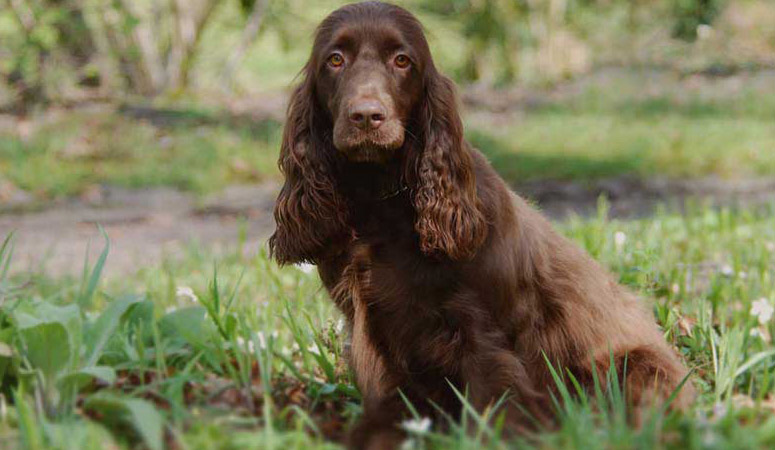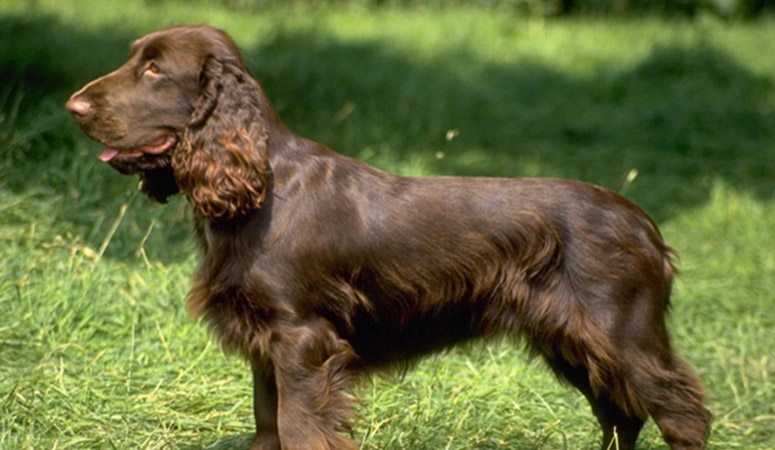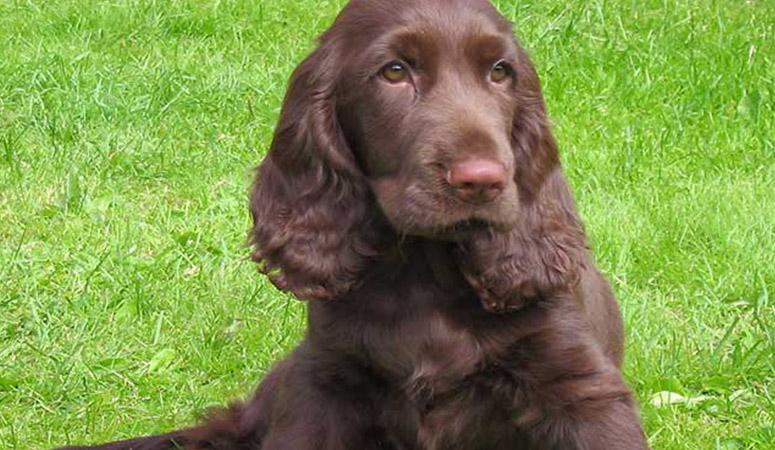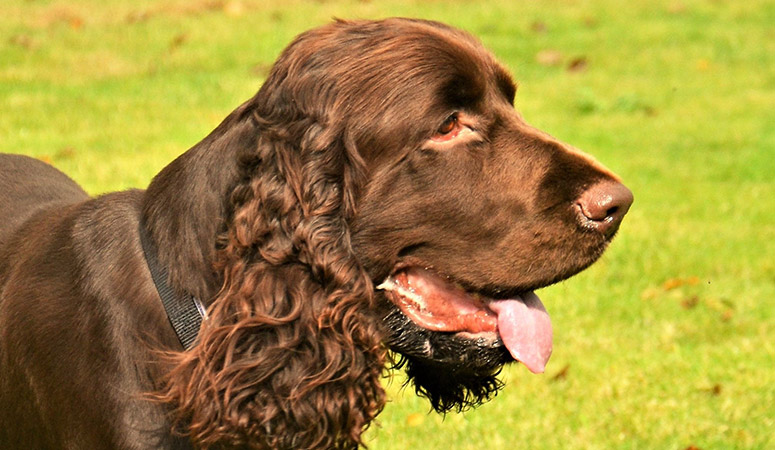Field Spaniel
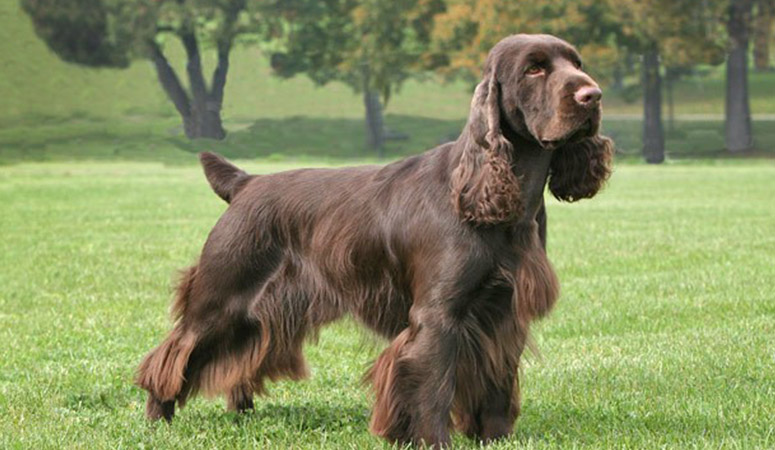
| Other Names | Fields |
| Color | Black, Blue Roan, Golden Liver, Golden Liver Roan, Liver, Liver Roan |
| Height | Males: 16-18 inches. Females: 14-17 inches. |
| Weight | Males: 40-55 pounds. Females: 35-45 pounds. |
| Life Span | 12-13 years |
| Personality | Sweet, Fun-Loving, Sensitive |
| Exercise | Regular Exercise |
| Origin |
| Popularity | #153 |
| Groom Needs | Weekly Brushing |
| Kids Friendly | Yes |
| Dog Friendly | Yes with supervision |
| Watch Dog | |
| Family Dog | |
| Litter Size | 4 to 6 puppies |
Field Spaniel Pictures
Field Spaniel Video
Introduction
This sturdy, medium-sized dog, the Field Spaniel was years back developed to retrieve game from either the water or land. Today, they still retain their excellent hunting skills. Now they are wonderful friends and companions today for owners who love to have them – they give their family much entertainment with their high energy. And that means he has high exercise needs too; he needs plenty of space to run and go on daily walks. He loves water too, so prepare for him to make quite a mess around his watering dish! He stands around 7 inches at the shoulder and weighs around 45 pounds. They are good with children but don’t like rough and loud play. Although they are alert and will bark when visitors approach, they do not make the best guard dog. Field Spaniels are extremely sensitive dogs and do not respond well to loud tones of voice or harsh handling. If they are not getting plenty of human companionships and kept in a kennel or a yard alone, they are going to become neurotic and experience behavioral problems. His coat needs to be brushed regularly; it comes in colours such as black, liver, roan, golden liver, or any of those colours with tan points. There are some who have small amounts of white on the chest or throat.
Living with Field Spaniel
The lovely single coat is one of the breed’s most attractive features but requires regular care and maintenance.
Begin accustoming your Field Spaniel to being brushed and examined when he’s a puppy. Make grooming a positive experience filled with praise and rewards, and you’ll lay the groundwork for easy veterinary exams and other handling when he’s an adult.
Weekly brushing and combing will keep the coat shiny and help to reduce shedding. Fields may need minimal trimming about the head and feet. The breed is not to be body clipped as some other spaniels. Bathe the dog only as needed.
Trim his nails once or twice a month if your dog doesn’t wear them down naturally to prevent painful tears and other problems. If you’re not experienced trimming dog nails, ask a vet or groomer for pointers. Handle his paws frequently — dogs are touchy about their feet — and look inside his mouth.
Brush your Field Spaniel’s teeth at least two or three times a week to remove tartar buildup and the bacteria that lurk inside it. Daily brushing is even better if you want to prevent gum disease and bad breath.
His ears should be checked weekly for redness or a bad odor, which can indicate an infection. You should wipe their ears out with a cotton ball dampened with gentle, pH-balanced ear cleaner to help prevent infections. Don’t insert anything into the ear canal; just clean the outer ear.
Eyes should be clear, with no redness or discharge. Your careful weekly exam will help you spot potential health problems early.
Fields are found in a wide variety of lifestyles, from city to country, but do best when given challenges for both the mind and body. A healthy, adult Field Spaniel requires two to three hours of physical activity each day. Hunting is their favorite activity, but they excel in most dog sports and agility training.
The gentle Field Spaniel thrives in the company of his family and should live indoors with them. House friendly games such as hide and seek, and puzzle toys are good options for keeping him busy.
Field Spaniels also should spend much of their day outdoors getting the exercise they need to keep them healthy and happy. Hiking in the woods or jogging through the neighborhood will also suffice.
Be sure your yard is well secured because Fields will find small escape routes and set off after birds or squirrels. He does best when given a great deal of exercise with chances to run and explore. Just be aware that he has a tendency to follow his nose. He will also enjoy long walks on leash.
Field Spaniels love the water. With access to a pond, lake or stream, the Fields will frolic for hours, providing his family with laughter at his funny antics.
A Field who is out hunting all day will require more food than the dog that is less active. It is generally agreed that the breed will thrive on a good- quality, balanced diet that is nutritionally bioavailable. The recommended daily amount is about 1.5 to 2 cups of high-quality dry food a day, divided into two meals.
But how much your adult dog eats depends on his size, age, build, metabolism, and activity level. The quality of dog food you buy also makes a difference — the better the dog food, the further it will go toward nourishing your dog and the less of it you’ll need to shake into your dog’s bowl. Talk to your veterinarian about the optimal diet and quantity of food for your Field Spaniel.
Give table scraps sparingly, if at all, especially avoiding cooked bones and foods with high fat content.
Some Fields are prone to getting overweight, so watch your dog’s calorie consumption and weight level. Treats can be an important aid in training, but giving too many can cause obesity.
Clean, fresh water should be available at all times.
Learn about which human foods are safe for dogs, and which are not. Check with your vet if you have any concerns about your dog’s weight or diet.
Field Spaniels are generally healthy, but like all breeds, they’re prone to certain health conditions, such as hip dysplasia, hypothyroidism, otitis externa, epilepsy, ear infections and, autoimmune thyroiditis. Some dogs may suffer from eye conditions, including cataracts, ectropion, and progressive retinal atrophy.
Not all Field Spaniels will get any or all of these diseases, but it’s important to be aware of them if you’re considering this breed.
As with all breeds, the Fields’ ears should be checked regularly for signs of infection, and the teeth should be brushed often, ideally every day, using a toothpaste formulated for dogs.
There are several health tests considerations specific to the breed, such as ephthalmologic exam and hip evaluation.
Responsible breeders test all breeding stock for conditions that can affect the breed. Regular visits to the vet for checkups and parasite control help to ensure the dog a long, healthy life.
Total Annual Cost: $3177.9
Cost is estimated for the first year and may vary depending on many factors, such as dog food, health care, leash, collar, licensing, possible fencing, crates, training and obedience classes, dog-walking, grooming, treats, toys, flea, tick, and heart-worm meds, microchips, etc.
Fields are happiest when they are kept active and challenged. Although the Field Spaniel has an independent streak, he is relatively easy to train.
Like every dog, the Field Spaniel needs early socialization. Enrolling him in a puppy kindergarten class is a great start — exposure to many different people, sights, sounds, and experiences — when they’re young. Socialization helps ensure that your Field Spaniel puppy grows up to be a well-rounded dog.
Fields love their people and range from serious to clownish in attitude. Once they understand expectations, they are solid in training, and the breed excels in multiple canine sports and activities, including agility training, flyball, and dock jumping.
Though not one of the more well-known sporting dogs, the Field Spaniel’s adaptable and steady hunting style is appreciated by hunters in the know.
Fields tend to bore easily during training so the sessions should be short but repetitive.
This breed does not respond to harsh treatment or being manhandled. Patience and gentleness go a long way while training the Field Spaniel. Naturally, treats provide great motivation during training sessions.
They are also sensitive sorts, meaning a gentle approach yields the best results.
History
This dog originates from England.
In the later part of the 19th century, he was developed to be a medium-sized all-black dog. This was quite unusual as hunters usually looked for white dogs so they could be seen easily in the field.
In 1901 they were divided by weight, and if a dog weighed more than 25 pounds he was rated a field spaniel, and if he weighed less than 25 pounds, he was classified as a cocker spaniel.
The field spaniel started out as a popular breed, but he ended up being cross-bred by some breeding fanciers that the public was not impressed with. A man, Mortimer Smith, made an effort to bring back the field spaniel to look good again. There was a time, too, when they were on the verge of going extinct and it was only thanks to some dedicated breeders in England who kept the breed alive. Some were imported into the States and the revival of the breed began. But it’s a rare breed.
The AKC registered its first Field Spaniel, Colehill Rufus, in 1894. Unfortunately, there was a fire that destroyed a major kennel in 1909, and the breed disappeared in the United States, with the last registration occurring in 1930. Three dogs were imported in 1967, and it’s these three dogs form the basis of the breed today.
Helpful Information
Breed Club: FIELD SPANIEL SOCIETY OF AMERICA
Breed Club Link: https://www.fieldspanielsocietyofamerica.org/
Breed Club Rescue: Field Spaniel Society of America – Rescue
Breed Club Rescue Link: https://www.fieldspanielsocietyofamerica.org/rescue-questionnaire-2/

